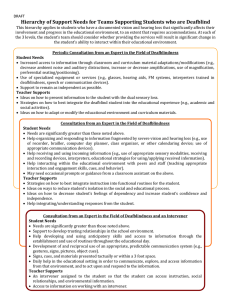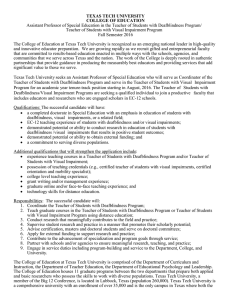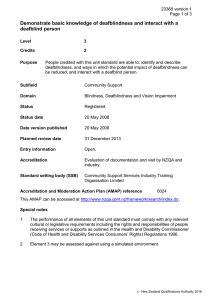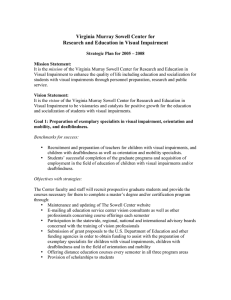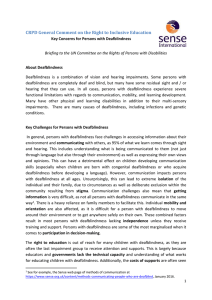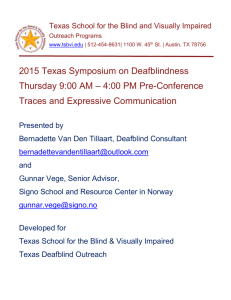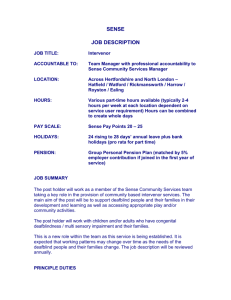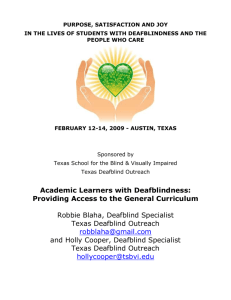The Right of Persons with Disabilities to Participate in Decision-Making
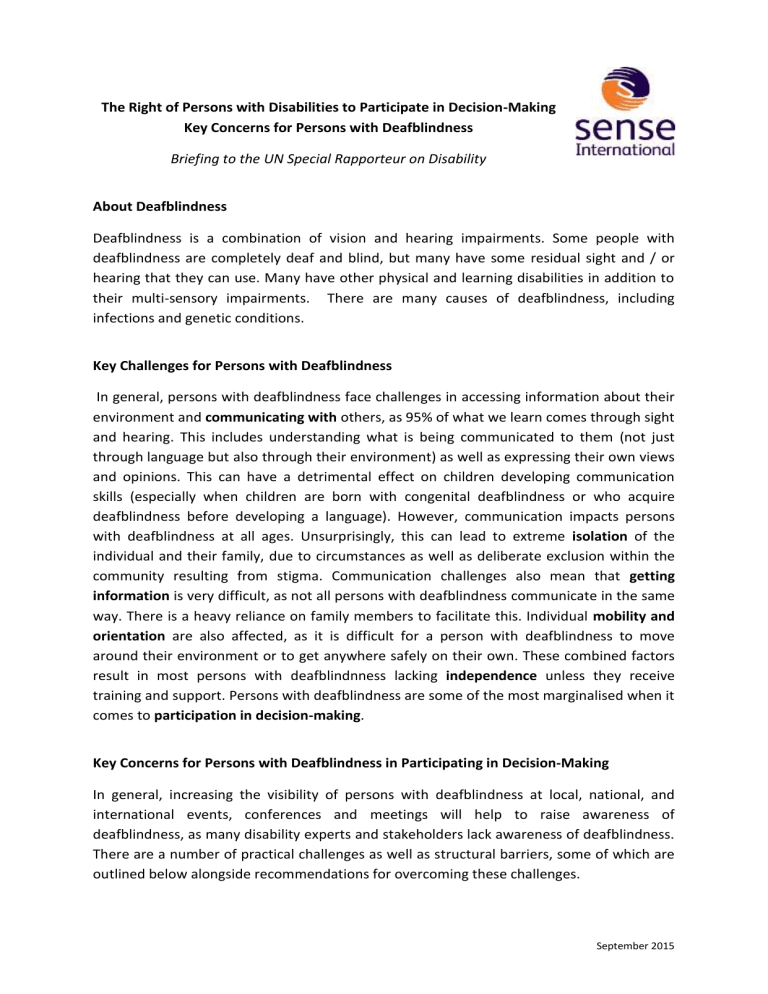
The Right of Persons with Disabilities to Participate in Decision-Making
Key Concerns for Persons with Deafblindness
Briefing to the UN Special Rapporteur on Disability
About Deafblindness
Deafblindness is a combination of vision and hearing impairments. Some people with deafblindness are completely deaf and blind, but many have some residual sight and / or hearing that they can use. Many have other physical and learning disabilities in addition to their multi-sensory impairments. There are many causes of deafblindness, including infections and genetic conditions.
Key Challenges for Persons with Deafblindness
In general, persons with deafblindness face challenges in accessing information about their environment and communicating with others, as 95% of what we learn comes through sight and hearing. This includes understanding what is being communicated to them (not just through language but also through their environment) as well as expressing their own views and opinions. This can have a detrimental effect on children developing communication skills (especially when children are born with congenital deafblindness or who acquire deafblindness before developing a language). However, communication impacts persons with deafblindness at all ages. Unsurprisingly, this can lead to extreme isolation of the individual and their family, due to circumstances as well as deliberate exclusion within the community resulting from stigma. Communication challenges also mean that getting
information is very difficult, as not all persons with deafblindness communicate in the same way. There is a heavy reliance on family members to facilitate this. Individual mobility and
orientation are also affected, as it is difficult for a person with deafblindness to move around their environment or to get anywhere safely on their own. These combined factors result in most persons with deafblindnness lacking independence unless they receive training and support. Persons with deafblindness are some of the most marginalised when it comes to participation in decision-making.
Key Concerns for Persons with Deafblindness in Participating in Decision-Making
In general, increasing the visibility of persons with deafblindness at local, national, and international events, conferences and meetings will help to raise awareness of deafblindness, as many disability experts and stakeholders lack awareness of deafblindness.
There are a number of practical challenges as well as structural barriers, some of which are outlined below alongside recommendations for overcoming these challenges.
September 2015
1.
Initial Communication and Access to Information – In order to participate in any process, people must be made aware of opportunities to participate. This places the burden on organisers of these processes to understand the specific challenges that persons with deafblindness experience in receiving information so that they are made aware of the opportunities to participate. Most often, traditional communications methods, such as email, leaflets, and radio announcements, are not likely to reach persons with deafblindness. Although some persons with deafblindness are able to use traditional methods for receiving information, it should not be assumed that persons with deafblindness will be reached through traditional communication methods. Therefore, it is essential that organisers of participation processes conduct outreach aimed at persons with deafblindness and make a
concerted effort to go beyond traditional communication methods for persons with disabilities, such as braille flyers or even face-to-face contact. One way to include persons with deafblindness is for organisers of participation processes to contact organisations and community groups that specifically work with persons with
deafblindness, who may be able to relay messages to individuals and families.
2.
Focal Points to Facilitate Deafblind Participation – Disabled People’s Organisations
(DPOs) serve as a potential source for reaching persons with disabilities, and many
DPOs successfully engage in regular advocacy and government consultation.
However, DPOs experience some of the same challenges that governments face in ensuring the inclusion of persons with severe or profound disabilities, including deafblindness. This stems from a general lack of understanding of the needs of persons with deafblindness and how to accommodate their communications needs.
Therefore, it is important for governments to promote and support awareness- raising within DPOs on deafblindness and to support measures for integrating
persons with deafblindness into DPOs. Where there are DPOs specifically focused on deafblindness, they often lack resources and capacity, and they may struggle with access to information and communication. Because of these challenges, Deafblind
DPOs should be supported and enhanced through increased outreach by
stakeholders, and financial and capacity building supports.
National Councils on Disability and other State-supported bodies and mechanisms also have the potential to support and facilitate the participation of persons with deafblindness. Often, however, these bodies similarly lack the expertise and understanding of deafblindness. National bodies responsible for facilitating the participation of persons with disabilities should undergo training and sensitisation
on deafblind communication and the needs of persons with deafblindness. As an example, Sense International Peru advocated for and facilitated the appointment of a deafblind specialist in the National Council for the Integration of Persons with
Disabilities (CONADIS) to facilitate communication and support of persons with deafblindness.
September 2015
Parents’ and family members’ support groups provide an essential support to persons with deafblindness and to each other, and many engage in advocacy. These community-based groups have a deep understanding of the concerns of persons with deafblindness and will often engage in advocacy on their behalf. Therefore, parents’ and family members’ groups can serve as an ally in facilitating the
participation of persons with deafblindness. However, governments should be aware that there is often an over-reliance on family members to facilitate participation. Furthermore, because family members are usually affected by disability policies and programmes, it can be difficult to extract the views of persons with deafblindness from their family member’s views. It may be useful to include the voices of family members in parallel participatory processes to ensure that their
voices are also heard.
3.
Participatory Meetings - When decision-making processes require participation at central meeting points, such as forums and workshops, persons with deafblindness in many countries, such as Tanzania, may not have the financial resources to travel to such venues. It may be necessary for organisers to consider reimbursement of travel expenses or subsidies for persons with deafblindness and their guide
interpreters where their input is desired. In addition, persons with deafblindness can be more susceptible to harassment and abuse, particularly for women and girls, when travelling to central meeting points. Therefore, protection measures should be adopted by organisations, which may include holding multiple local events or
other alternatives.
Often, the time frame for such forums at which decisions are made is too brief for persons with deafblindness, because they need more time to communicate in order to receive information, process this information and formulate their responses.
Therefore, organisers should build in sufficient time to accommodate persons with
deafblindness in the communication process.
4.
Guide Interpreters - Persons with deafblindness do not all use the same method for communicating and the method(s) of communication may be unique to each individual. Some may be able to speak and / or hear but with limited ability, depending on their range. Others may use tactile communications, such as deafblind manual, hands-on sign language or block sign language. Some may be able to use braille or sign language, and others may rely on objects of reference. A guide interpreter supports a person with deafblindness to access information about the environment (e.g., orientation and mobility) as well as interpreting communication
(i.e., the exchange of information). Guide interpreters enable the participation of persons with deafblindness, and are likely to be more independent than family members in facilitating communication. However, the availability of guide interpreters varies from country to country. For example, there is legislation to
September 2015
provide guide interpreters in Peru. States should provide access to guide
interpreters in order to facilitate the participation of persons with deafblindness.
There is a significant expense associated with guide interpreters because unlike sign language which can benefit a group of persons with hearing impairments, one guide interpreter is usually required for each person with deafblindness.
5.
Children with Deafblindness – There are particular considerations for children with deafblindness, especially for children that are learning how to communicate. In many instances, special educators for children and young people with deafblindness can
facilitate participation of these children. Organisers of participation processes should liaise with special education teachers and outreach workers for those that utilise community-based education and should allow enough advance notice to ensure adequate planning.
6.
Identification of Impairment Groups and Recognition of Deafblindness – Another challenge in facilitating participation revolves around the identification of impairment groups and whether or not deafblindness is recognised as a disability.
For States that recognise deafblindness in legislation, persons with deafblindness
are more likely to have access to services to support participation.
Deafblindness can often be misinterpreted as a learning or intellectual disability, especially by unaware and untrained individuals, which can lead to the wrong kind of support. Furthermore, some with deafblindness are categorised as either deaf or blind, resulting in supports that are inadequate to meet the needs of persons with deafblindness. However, persons with deafblindness are often put into a general category for multiple impairments, which does not highlight the shared concerns of persons with deafblindness as a group or their unique communication needs.
Establishing specific accessibility criteria for impairment groups, including deafblindness, may help to prevent this and to ensure that groups that are more
marginalised are enabled to participate.
7.
Developing Decision-Making Skills - Persons with deafblindness face considerable challenges in making the everyday decisions that affect their lives as well as participating in government processes. There is a strong link between the right to education and the right to participate for individuals that face severe communication barriers. These barriers often lead to decisions being made on their behalf because it is thought to be too difficult to communicate. This leads to substitute decisionmaking, and for some, they may not learn to develop the skills to make decisions.
Education programmes and curricula need to incorporate skills on decision-making, participation, independence and communications so that persons with deafblindness can be included into decision-making processes and contribute
meaningfully to decisions that affect them.
September 2015
About Sense International
Sense International (SI) is a global charity that supports persons with deafblindness in
Bangladesh, India, Kenya, Peru, Romania, Tanzania, and Uganda. We provide expertise and training to local partners on models for delivering services to persons with deafblindness.
We also advocate to governments to develop services and to promote the rights of persons with deafblindness. For https://www.senseinternational.org.uk/ . more information, visit us at
This briefing was prepared by Sense International’s Advocacy and Policy Manager, Bailey
Grey, and it is based on SI’s programme experience across four continents. For questions related to this briefing, please contact bailey.grey@senseinternational.org.uk
.
September 2015
